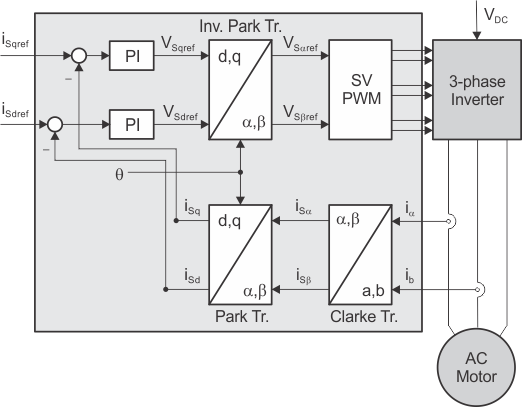SPRACM9B June 2019 – November 2020 TMS320F28384D , TMS320F28384S , TMS320F28386D , TMS320F28386S , TMS320F28388D , TMS320F28388S , TMS320F28P650DH , TMS320F28P650DK , TMS320F28P650SH , TMS320F28P650SK , TMS320F28P659DH-Q1 , TMS320F28P659DK-Q1 , TMS320F28P659SH-Q1
- Trademarks
- 1 Introduction
- 2 Benefits of the TMS320F2838x MCU for High-Bandwidth Current Loop
- 3 Current Loops in Servo Drives
- 4 Outline of the Fast Current Loop Library
- 5 Fast Current Loop Evaluation
- 6 Incremental Build Level 1
- 7 Incremental Build Level 2
- 8 Incremental Build Level 3
- 9 Incremental Build Level 4
- 10Incremental Build Level 5
- 11Incremental Build Level 6
- 12Incremental Build Level 7
- 13Incremental Build Level 8
- 14References
- 15Revision History
3 Current Loops in Servo Drives
Figure 3-1 shows the basic current loop used in FOC servo drives.
 Figure 3-1 Basic Scheme of FOC for AC
Motor
Figure 3-1 Basic Scheme of FOC for AC
MotorTwo motor phase currents are measured. These measurements feed the Clarke transformation module. The outputs of this projection are designated isα and isβ. These two components of the current along with the rotor flux position are the inputs of the Park transformation, which transform them to currents (isd and isq) in d and q rotating reference frame. The isd and isq components are compared to the references isdref (the flux reference) and isqref (the torque reference). At this point, the control structure shows an interesting advantage; it can be used to control either synchronous or asynchronous machines by simply changing the flux reference and obtaining the rotor flux position. In the synchronous permanent magnet motor, the rotor flux is fixed as determined by the magnets, so there is no need to create it. Therefore, when controlling a PMSM motor, isdref can be set to zero, except during field weakening.
Because ACIM motors need a rotor flux creation to operate, the flux reference must not be zero. This conveniently solves one of the major drawbacks of the classic control structures: the portability from asynchronous to synchronous drives. The torque command isqref can be connected to the output of the speed regulator. The outputs of the current regulators are Vsdref and Vsqref. These outputs are applied to the inverse Park transformation. Using the position of rotor flux, this projection generates Vsαref and Vsβref, which are the components of the stator vector voltage in the stationary orthogonal reference frame. These components are the inputs of the Space Vector PWM. The outputs of this block are the signals that drive the inverter.